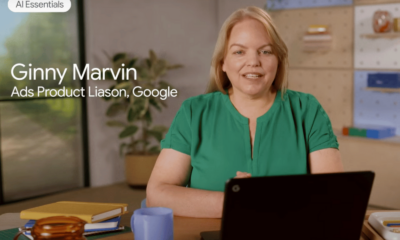MARKETING
How We Increased a Client’s Leads by 384% in Six Months by Focusing on One Topic Cluster [Case Study]
![How We Increased a Client’s Leads by 384% in Six Months by Focusing on One Topic Cluster [Case Study] How We Increased a Client’s Leads by 384% in Six Months by Focusing on One Topic Cluster [Case Study]](https://articles.entireweb.com/wp-content/uploads/2022/09/1664258726_How-We-Increased-a-Clients-Leads-by-384-in-Six.png)
The author’s views are entirely his or her own (excluding the unlikely event of hypnosis) and may not always reflect the views of Moz.
Content marketing is an essential part of any SEO strategy. Without it, how are you going to attract customers looking for answers to their questions, and who are potentially in the market for your products or services?
At Tao Digital Marketing, we’ve recently generated some great results for one of our clients operating in the business financial space, The Insolvency Experts, mainly by focusing on just one “cluster topic” that was a huge money maker for them.
When looking at six month comparison stats (August 2021-January 2022 to February-July 2022), we’ve achieved the following:
-
Leads: 95 to 460 (384%)
-
Clicks: 4,503 to 23,013 (411%)
-
Impressions: 856,683 to 2,033,355 (137%)
-
Average position: 33.4 to 23.6 (increased almost 10 spots)
This was mostly achieved by absolutely hammering one topic area: company liquidation. In this case study, we’re going to explain how we did this step by step, so that hopefully you can generate similar results for your own business!
Objectives
If you really break it down, the objective of all SEO consultancy work is essentially the same: increase the number of leads for a business. This was our ultimate goal.
It’s not just as simple as that, though. We all know you can’t get to number one on Google overnight. So, like other SEO geeks out there, we tracked our successes through additional factors such as clicks, impressions, and average position, to show our efforts were worthwhile.
In January this year (2022) our goals for the next six months were as follows:
-
Leads: Just over double from 95 to 200 (110%)
-
Clicks: 4,503 to 13,500 (around 200%)
-
Impressions: 856,683 to 1,700,000 (around 100%)
-
Average position: 33.4 to 25 (around eight spots)
Insolvency Experts’ audience is primarily directors of UK businesses that are going insolvent, closely followed by business owners looking for financial advice. The majority of Insolvency Expert’s cash flow comes from formal insolvency processes, such as liquidation, administration, and CVAs (Company Voluntary Agreements), so it was really important for us to push these areas.
Our strategy
1. Research “company liquidation” search volume and related queries
We first picked this client up in November 2020. Initially, our focus was on the basics: updating all the top level pages (such as service pages and guides) to make sure they fit the intention of the user and clearly explained the services that Insolvency Experts offer.
Researching what works well at present
One of the pages that our content team updated was their company liquidation guide. After updating, the page started to perform very well in the SERP, and ranked at position #4 for “company liquidation”. Clearly, this sort of content was working, and we wanted to hit it even more.
After pulling some research together, one of our strategists proposed the idea of a “Company Liquidation Content Hub”, as the company liquidation guide was ranking for a lot of long tail questions:
After cross referencing with the monthly search volume for these questions, she added some of these as H3s within the guide to see how they would perform. They resulted in so much more traffic that she decided they warranted their own individual guides, hence the idea for the hub. This would mean we weren’t putting all of our eggs into one basket, and that we could also internally link all of them together for users wanting to read more.
Users that are further down the marketing funnel don’t want to scroll down a huge guide to find the answer to their specific question, and we were certain that this would positively affect bounce rate. We therefore made sure that nine times out of 10, the H1 contained the question that was being answered.
![How We Increased a Client’s Leads by 384% in Six Months by Focusing on One Topic Cluster [Case Study] Infographic explaining the sales funnel, starting with reach followed by act, convert and finally, engage](https://articles.entireweb.com/wp-content/uploads/2022/09/How-We-Increased-a-Clients-Leads-by-384-in-Six.png)
In order to further target those at the bottom of the marketing funnel who want to speak to someone quickly, we placed regular “Contact Us” CTAs throughout the content so that they don’t have to scroll right to the bottom of the page to get in touch with Insolvency Experts.
![How We Increased a Client’s Leads by 384% in Six Months by Focusing on One Topic Cluster [Case Study] An example of a piece of content with a ‘Get Free Liquidation Advice’ CTA in the middle](https://articles.entireweb.com/wp-content/uploads/2022/09/1664258707_469_How-We-Increased-a-Clients-Leads-by-384-in-Six.png)
Undertaking a competitor analysis
We also conducted a competitor analysis on this topic, focusing on three key players in the industry that were all ranking well for the phrase “company liquidation”. We found that the key competitors had the following:
Competitor A – 38 indexed articles on liquidation
Competitor B – 23 indexed articles on liquidation
Competitor C – 47 indexed articles on liquidation
Insolvency Experts only had six indexed articles on liquidation at the time, so it was clear we needed to be on their level – this was an obvious content gap.
Pitching the content hub to the client
We suggested this idea to the client alongside a forecasting spreadsheet created by our founder, in order to justify the resource that was needed to push the client as high as possible in the rankings for company liquidation.
This spreadsheet broke down a huge list of keywords alongside monthly search volume, average click through rate for positions 1-10 on the SERP, domain authority of competitors who are currently ranking for these keywords, and average conversion rate on the site at the moment.
![How We Increased a Client’s Leads by 384% in Six Months by Focusing on One Topic Cluster [Case Study] Table demonstrating projected revenue for Insolvency Experts depending on where they ranked on the SERP](https://articles.entireweb.com/wp-content/uploads/2022/09/1664258708_294_How-We-Increased-a-Clients-Leads-by-384-in-Six.png)
This unique formula would then allow us to explain to the client that for X amount of work, we predict we can get you to position X in X timeframe, and this would result in approximately X annual revenue. After pitching this to the client alongside infographics and current performance statistics, they told us they loved our ideas and agreed to let us go ahead.
2. Plan the content after client approval
After the client gave us the go-ahead, the next step was to plan all of this work based on search volume, and therefore priority order.
It’s easy to get lost in all the data within SEO, so it was incredibly important for us to have a solid plan and timeline for these changes. Topics were going to range from How to Liquidate a Company with No Money through to Administration vs Liquidation.
How we communicate planned works to our clients
In order to orchestrate clear communication between ourselves and our clients, we create a Traffic Light Report, which is a live Google Sheets document detailing all work to be undertaken for the current and next quarter. This is split into sections for technical SEO, content, and digital PR/link building (the three pillars of SEO).
This includes justification for each change we make, as well as a link to any live changes or documents. It also details when this will be done and if the action is with us or the client. The tasks are coloured in green for live changes, yellow for action needed, orange for in progress, red for anything on hold and clear for not started.
Here’s an example of what the content section of Insolvency Expert’s traffic light report looks like for their current quarter (July-September 2022):
Scheduling the tasks
We then scheduled these topics for our various content writers to work on using our project management software, ClickUp. Within each task we placed a link to a skeleton document consisting of H1s, H2s, and H3s, as well as a title, meta description and keywords to include.
3. Write the content while implementing technical SEO
By this time it was around April 2022, and it was time for us to fully attack the content portion of our task list. Since then, we’ve written 18 pieces of content around company liquidation, and still have quite a few left to go before we consider this area of focus complete.
As part of our uploads, our technical SEO adds FAQ schema, which has helped Insolvency Experts showing up for several featured snippets (more details in results section).
Analyzing as we go along
Once we covered the big topics in the first couple of months of writing, we started to use Low Fruits to find smaller queries which are estimated at around 10 or fewer monthly searches. We’ve had a lot of success targeting lower search volume phrases, as these users seem to be more focused and lower down the sales funnel, so are more likely to be better engaged and convert better. A lot of the time they are pleased that you have answered their very niche question!
The below is a screenshot from a keyword analysis. We trawled through hundreds of keywords to pull out the ones relevant to the client.
We then used Low Fruit’s Keyword Extraction and SERP Analysis tool to give us further details on a select few key terms.
These terms are shown as having a search volume of either 10, less than 10 or 0. Of course, we know that this is still hugely important to cover, and targeting these will bring in a very niche reader who is much more likely to convert due to the nature of the long-tail queries.
Finalizing the hub
Our plan is to finalize the hub this fall, and ensure that everything is internally linked. There will also be a menu change to make the addition of the hub very clear. See screenshots below for the current hub vs. how it will be presented once all content is ready (screenshot taken from their staging site in Kinsta, our hosting platform where we make design changes so that the client can approve them before they go live).
Current ‘hub’ in the menu:
![How We Increased a Client’s Leads by 384% in Six Months by Focusing on One Topic Cluster [Case Study] Screenshot of the current ‘liquidation’ drop down menu, featuring four pieces of content](https://articles.entireweb.com/wp-content/uploads/2022/09/1664258710_402_How-We-Increased-a-Clients-Leads-by-384-in-Six.png)
How the hub will look once all content is complete:
![How We Increased a Client’s Leads by 384% in Six Months by Focusing on One Topic Cluster [Case Study] Screenshot sharing newer version of liquidation hub menu from Kinsta staging site](https://articles.entireweb.com/wp-content/uploads/2022/09/1664258711_686_How-We-Increased-a-Clients-Leads-by-384-in-Six.png)
As part of our content process within ClickUp, we have a recurring task to check a new URL in Google Search Console two weeks after upload. This allows us to see if we have the “Google Spike of Acceptance”, which is a sharp incline of impressions/traffic indicating that the content will do well, before it falls then slowly rises again.
![How We Increased a Client’s Leads by 384% in Six Months by Focusing on One Topic Cluster [Case Study] A screenshot showing the ‘Google Spike of Acceptance’ in Google Search Console - a sharp spike of clicks and impressions after upload](https://articles.entireweb.com/wp-content/uploads/2022/09/1664258711_794_How-We-Increased-a-Clients-Leads-by-384-in-Six.png)
If we don’t see this spike, we carry out multiple checks, including: Is it an orphan page? Are there any technical errors? Is it indexed? If it is not indexed, we push the URL through Index Me Now.
If the issue is just that the piece isn’t getting picked up, we will take another look at the content to see if there is something else we can do to improve it, e.g. tweak the H1 or expand the content.
4. Build links to the relevant pages and homepage
Once we’d uploaded the content, it was time to build links to the priority pages and homepage in order to build the domain authority.
We wanted to really hone in on generating links for our company liquidation page. The page has 36 backlinks, many of which were built through link building efforts. This was largely done by working with business site publications and creating natural anchor text that would help with certain keyword rankings.
As well as building links specifically to the company liquidation page, we also built links to the main URL in order to boost overall domain authority. This was done through answering queries through platforms such as HARO and Response Source, as well as working with the client to create relevant, time-specific thought leadership pieces. Here’s an example of a HARO request we responded to, the topic being “Recession-proofing tips for small businesses”:
![How We Increased a Client’s Leads by 384% in Six Months by Focusing on One Topic Cluster [Case Study] 1664258712 27 How We Increased a Clients Leads by 384 in](https://articles.entireweb.com/wp-content/uploads/2022/09/1664258712_27_How-We-Increased-a-Clients-Leads-by-384-in-Six.png)
Although the site’s domain authority tends to fluctuate between 30-33 depending on links lost and general algorithm updates, the links to specific pages have still resulted in an increase in rankings, detailed further below.
Results compared to objectives
Although we knew that our strategy was going to work well based on our experience with our other clients, we were very pleasantly surprised by the huge positive effect our work has made, which enabled us to smash the targets we set!
Leads
Goal: Increase from 95 to 200 (110%)
Result: Increased from 95 to 460 (384%)
As a result of creating incredibly useful, lengthy content and placing regular CTAs throughout the content, we managed to almost quadruple the amount of leads coming through to the client in the space of just six months.
In the six months before our liquidation project began, our Leads Dashboard within WhatConverts shows that Insolvency Experts had five liquidation leads via phone call and 10 leads via their contact form on a liquidation-focused page.
In the six-month period since we’ve been working on the content hub, they have had 38 liquidation leads via phone call and 52 leads via contact form on a liquidation-focused page.
Result: 660% increase in phone call leads and 420% increase in contact form leads.
Previous six months:
![How We Increased a Client’s Leads by 384% in Six Months by Focusing on One Topic Cluster [Case Study] Screenshot of the leads dashboard within What Converts showing that five leads were generated before work on the content hub began](https://articles.entireweb.com/wp-content/uploads/2022/09/1664258713_186_How-We-Increased-a-Clients-Leads-by-384-in-Six.png)
Current:
![How We Increased a Client’s Leads by 384% in Six Months by Focusing on One Topic Cluster [Case Study] Screenshot of the leads dashboard within What Converts showing that 38 leads were generated after work on the content hub began](https://articles.entireweb.com/wp-content/uploads/2022/09/1664258713_568_How-We-Increased-a-Clients-Leads-by-384-in-Six.png)
Clicks
Goal: Increase from 4,503 to 13,500 (around 200%)
Result: Increased from 4,503 to 23,013 (411%)
By creating highly relevant content that matched the user’s search intent, we managed to almost quadruple the clicks over the space of six months, doubling our original 200% goal.
The site has received 29,400 clicks overall across the past 12 months. Below, you can see the huge spike in clicks and impressions from January onwards when we really started to focus on the liquidation content.
![How We Increased a Client’s Leads by 384% in Six Months by Focusing on One Topic Cluster [Case Study] Screenshot showing spike in clicks and impressions once focus on ‘company liquidation’ began](https://articles.entireweb.com/wp-content/uploads/2022/09/1664258714_83_How-We-Increased-a-Clients-Leads-by-384-in-Six.png)
Impressions
Goal: Increase from 856,683 to 1,700,000 (around 100%)
Result: Increased from 856,683 to 2,033,355 (137%)
Again, by creating highly relevant blogs, Google started to understand the relevancy of our content, so the number of impressions hugely increased. Along with the 137% increase above, over the past 12 months (August 2021-August 2022) the site has received 485,000 impressions for the query ‘liquidation’ alone.
The main company liquidation guide that we updated had a total of 732K impressions over the past 12 months, too, with a huge spike from February onwards, when we updated the guide.
Average position
Goal: Increase from 33.4 to 25 (around 8 spots)
Result: Increased from 33.4 to 23.6 (increased 10 spots)
This increase is due to the relevancy of our content and the amount of keywords each piece ranked for. As mentioned, the main company liquidation guide has worked incredibly well, ranking for 181 keywords, 67 of which are page one (37%). It now has the number one spot for the term “company liquidation”. See below for an example of queries the page is showing up for.
The page also shows up for six featured snippets as a result of us implementing FAQ schema.
335 clicks and 93,663 impressions have come from the FAQ rich results alone.
In the six months before we updated the guide, it pulled in around 650 clicks and 227K impressions. In the six months following, it brought in around 1,180 clicks and 382K impressions. We’ve practically doubled clicks on one single guide.
As mentioned, this particular piece of content has 36 backlinks, and actually ranks ABOVE the official UK government company liquidation guide, which has a domain authority of 93 (about 60 higher than ours). Clearly, we’re meeting the searcher’s intent and giving them what they are looking for.
In the six month period before we started work on liquidation, Insolvency Experts had an average click through rate of 0.5%. Over a six month period of us working with them, this more than doubled to 1.2%.
Another success worth noting is that 3 out of 6 of our latest articles have an average page view duration of between 9 and 10 minutes! The other half are averaging around 5 to 6 minutes, which is still very good. Clearly, users are wanting in-depth information on this topic.
The “What happens to a director of a company in liquidation?” guide, which went live in May, is now the fifth most clicked page on the site. when filtered on GSC by the term “liquidation”.
Overall, we’re extremely pleased with the results we generated, and so are Insolvency Experts — the company liquidation department is now inundated with queries and they are rushed off their feet!









![Holistic Marketing Strategies That Drive Revenue [SaaS Case Study] Holistic Marketing Strategies That Drive Revenue [SaaS Case Study]](https://articles.entireweb.com/wp-content/uploads/2024/09/Holistic-Marketing-Strategies-That-Drive-Revenue-SaaS-Case-Study-400x240.png)
![Holistic Marketing Strategies That Drive Revenue [SaaS Case Study] Holistic Marketing Strategies That Drive Revenue [SaaS Case Study]](https://articles.entireweb.com/wp-content/uploads/2024/09/Holistic-Marketing-Strategies-That-Drive-Revenue-SaaS-Case-Study-80x80.png)


You must be logged in to post a comment Login